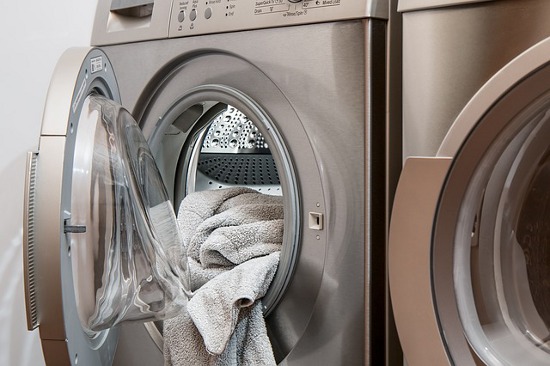Front-loading machines are preferred by many homeowners due to their efficiency, economical use of energy and water and a gentler cleaning effect on the clothes. The old water-guzzling machines loaded from the top have been substituted for these newer models.


Of course, there isn’t a perfect model, so front-loading washing machines have expensive repairs and parts, and sometimes it’s more economical to simply buy another washing machine.
No matter how old your washing machine is, some simple maintenance tricks will ensure the machine lasts much longer than you would expect. Some washing machines have a self-cleaning option but that’s not the only way to prevent issues. The tricks are not expensive or complex – just a few simple changes in your laundry habits will make sure your front-loading washing machine goes a long way without any breaks and stay efficient.
1. Use HE machine detergent
Detergent made for HE (high-efficiency) machines should also be used in the minimum amount. In many cases, using more detergent than necessary can even harm the washing machine, as more suds are produced, causing a build-up of a film on the drum and hoses. The same thing can happen when using regular detergent, which naturally produces more suds, consequently causing mould, electrical and mechanical damage to the machine.
Always carefully read the label on the detergent. Even though some detergents are marked “HE compatible”, they can produce a lot of suds, which can be difficult to remove because high-efficiency washing machines use less water.
2. Use the Eco Drum Clean cycle
This type of cycle is a cleaning cycle used for removing the residue from the detergent and the build-up. This cycle should be performed every forty washes.
3. Mind the hoses
The area between the machine and the wall should be at least four inches wide. This will prevent the hoses from kinking.
Also, inspect the hoses regularly for cracking, bulging, leaks, and fraying around the ends. Even if you don’t see any damage, replace the hoses every 3-5 years as a part of regular maintenance.
4. Leave everything open after washing
When the washing is over, leave the door and the dispenser drawer slightly open for a while. It will allow the machine to dry completely, preventing bad smells from occurring. The dispenser drawer should also be cleaned once a month under running water.
5. Use less softener
Liquid fabric softeners should be used in moderation. You could also consider skipping them completely. Still, if you want to use a liquid softener, then one tablespoon of concentrated bleach or two tablespoons of regular one will suffice. As high-efficiency machines use less water, it also means less product is necessary.
6. Don’t overload the machine
Of course, different programs work best with different workloads, so it’s best to check the instructions first to identify the right load fora specific program. In case you are washing clothes that have been heavily stained, then you should load only two-thirds of the machine.
7. Clean the drain pump filter
You should clean out this filter at least every few weeks, or whenever you notice there’s an issue with excessive vibrations of the machine, water drainage or wet clothes after the final spin. Fabric, hair or even small objects can get stuck in the drain pump filter, which slows down the drainage of the water. Different machines have the filter on different locations, but the filter is located at the front and the bottom of the machine, hiding behind a tiny trapdoor. Not cleaning it regularly could lead to bigger issues, which will demand professional appliance repair if you don’t want to cause further damage.
8. Use vinegar for cleaning
Use half-half water and vinegar solution for cleaning the washer’s door’s rubber seals. Q-tips will help you clean the areas that are difficult to reach. Removing fabric or hair that you find will prevent smells, sludge, and mould from developing. Use the same solution for wiping the inside of the drum.
It’s also a good idea to run an empty cycle with vinegar once a month. Pour some distilled white vinegar into the dispenser (just like you would use detergent), and add a cup of baking soda directly into the drum. This will help neutralize the pH but will also thoroughly scrub the inside of the machine. You can either run a hot cycle (at 95°C), giving an extra rinse, or use a self-cleaning program, for example, SterilTub (in case it’s offered on your washing machine). Vinegar is excellent for preventing bacteria and limescale from developing. In case of really strong smells of mildew, use bleach instead of vinegar and run a couple of quick cycles with hot water.
9. Select the appropriate spin speed
The spin speed you select has to be appropriate for the load that’s being washed. If you use higher speed, that means drier clothes before you put them in the dryer. However, it also means there could be extra wear on the machine’s inner parts.
10. Mind the small objects
Before you put the laundry in the washing machine, check all the pockets for objects like coins or hair clips. You need to check the door seal, too, in case there are foreign objects stuck.
It’s also recommendable to use a fine laundry net for small items like socks or gloves because they can get caught around the door. Machine-washable bras have metal parts that can break through material and damage the machine, too.
11. Keep the machine level
It’s very important to keep the machine level because otherwise, it can rock, vibrate or even move across the floor during the spin cycle. This could damage the floor or the washing machine. You can balance the machine by turning its legs clockwise to lower it, and counterclockwise to raise it.
12. Immediately remove finished loads
Don’t let damp clothes stay inside the washing machine for too long. This is a perfect environment for mildew and unpleasant smells. As soon as the machine is finished, take out the laundry.
Final words
Regular inspection and appropriate everyday use of your washing machine will make sure you have a minimum number of issues and a longer lifespan of the washing machine.









